United Kingdom is a country in northwestern Europe. It consists of four political divisions—England, Scotland, Wales, and Northern Ireland. England, Scotland, and Wales make up the island of Great Britain. Northern Ireland occupies the northeastern part of the island of Ireland. The nation’s official name is the United Kingdom of Great Britain and Northern Ireland. Most people shorten its name to the United Kingdom, the U.K., or Britain. London is the capital and largest city.
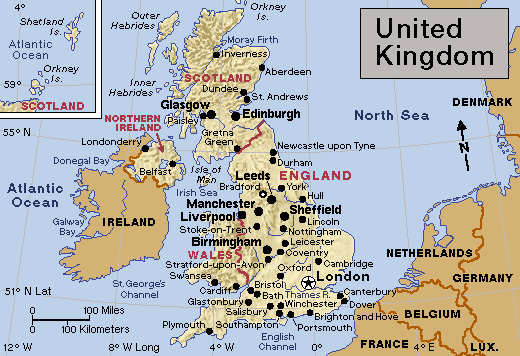
About 75 countries are larger in size than the United Kingdom. The country has only about 1 percent of the world’s people. But the United Kingdom has a rich history. Its history is the story of how a small country became the world’s most powerful nation. The British started the Industrial Revolution, a period of rapid industrialization that began in the 1700’s. They founded the largest empire in history. They have produced some of the world’s greatest scientists, explorers, artists, and political leaders.
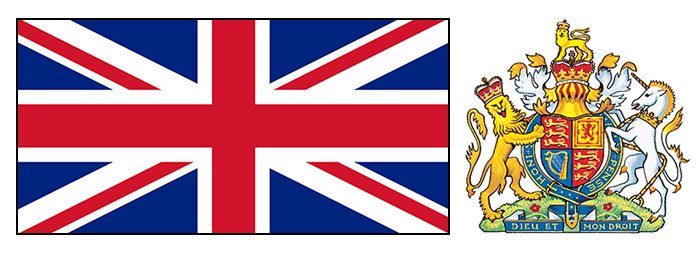
The landscape of the United Kingdom varies dramatically. Northern Scotland is a wild, windswept region. The land is broken by long arms of the sea that reach far inland. Much of Northern Ireland has low mountains and rolling fields. Wales is famous for its rugged mountains and deep, green valleys. Most of England is covered by rolling plains, laid out in a patchwork of fields and meadows. The coastline is a shifting scene of steep cliffs, golden beaches, and jagged rocks. Fishing towns are tucked in sheltered bays. The United Kingdom has magnificent old castles and modern nuclear laboratories. It has snug villages and sprawling cities. It also has ancient universities and new factories.
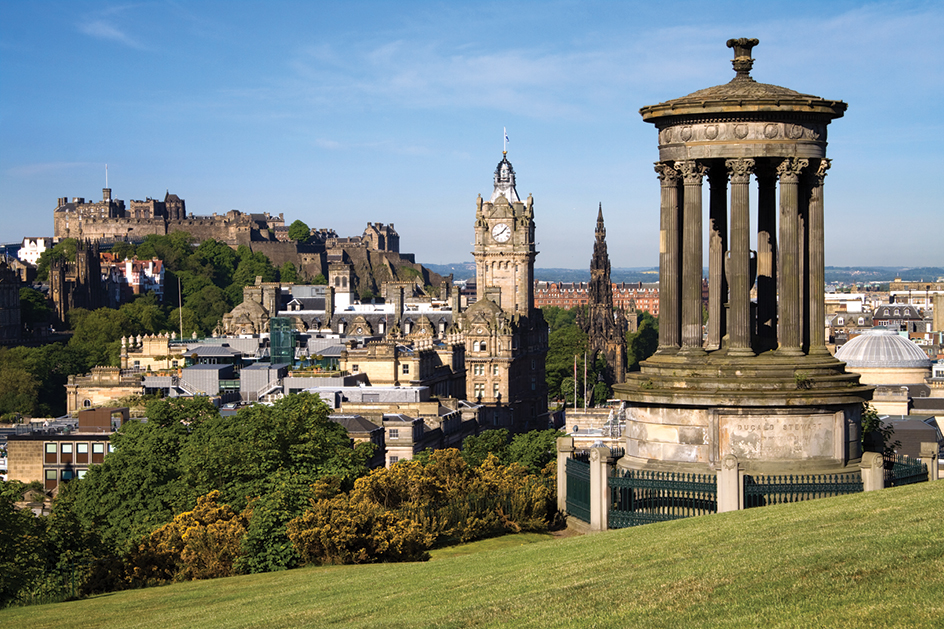
The English Channel separates the island of Great Britain from France. This narrow stretch of water helped shape the character and history of the British people. It helped protect the United Kingdom from invasion. It gave the people a feeling of security. In 1066, a group of Vikings called the Normans sailed across the channel from northwestern France and conquered England. After the Norman Conquest, no enemy ever again crossed the channel and invaded the country.
Cut off from the rest of Europe by the sea, the British developed their own character and way of life. They came to respect privacy and to value old traditions. They developed a dry wit and a high degree of self-criticism. They also developed a love for personal freedom. The British have shown themselves at their best—brave and united—in times of crisis. Their courage against German bombs and overwhelming odds during World War II (1939-1945) won the admiration of the world.
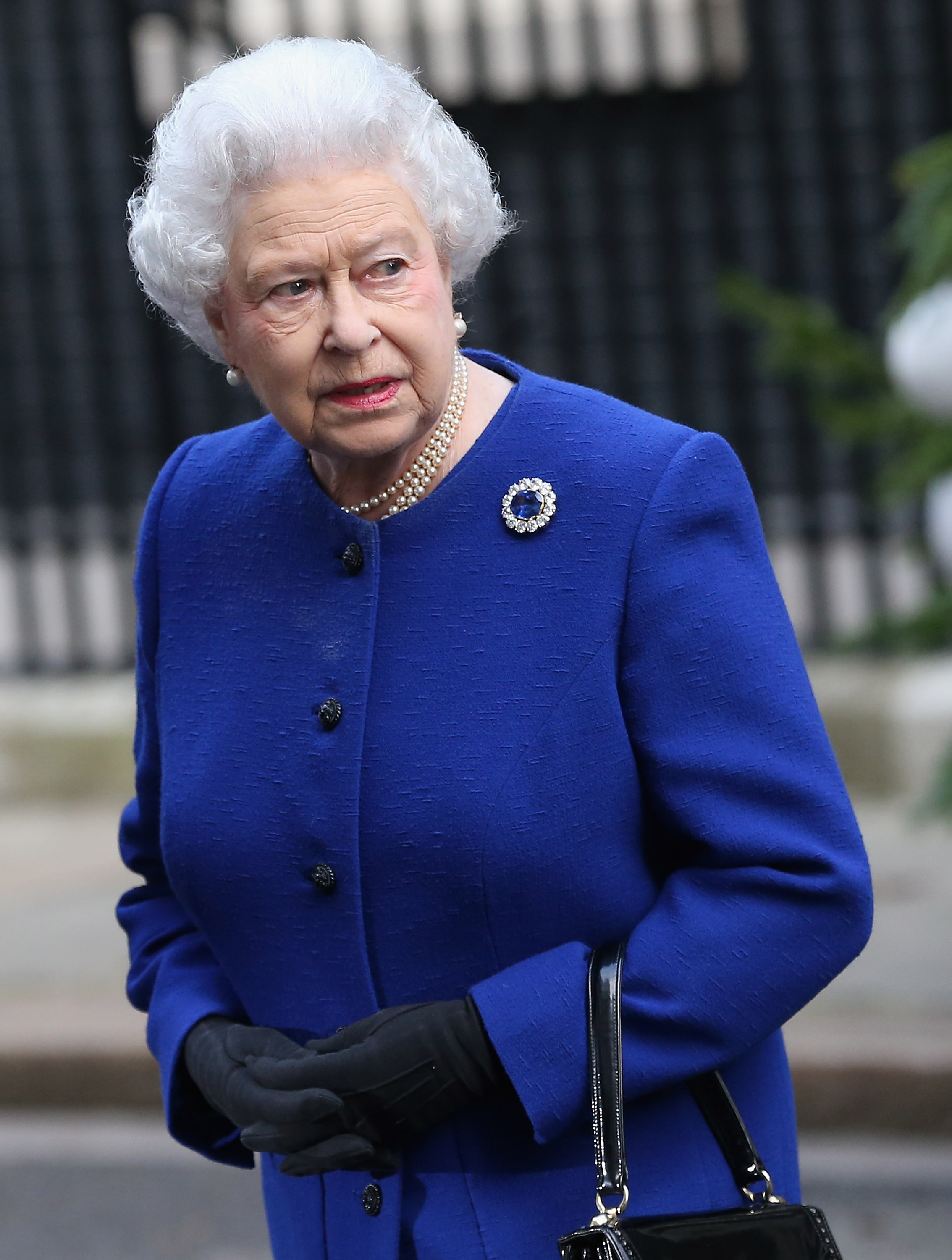
In the 1700’s, the Industrial Revolution made the United Kingdom the world’s richest manufacturing country. The British ruled the seas and were the world’s greatest traders. By 1900, they had an empire that covered about a fourth of the world’s land and included about a fourth of its people. The British spread their way of life throughout their empire.
Then came the 1900’s—and two crippling world wars. The British Empire began to break up as the United Kingdom’s colonies sought independence. The United Kingdom faced one economic crisis after another. Today, the United Kingdom is still a leading industrial and trading nation. But it is no longer the world power it once was.
People
Population.
The United Kingdom is more thickly populated than most countries. Most of its people live in cities and towns. About one-third of the country’s residents live in England’s seven metropolitan areas. Greater London, the largest metropolitan area, has more than 10 percent of the United Kingdom’s total population. The six other metropolitan areas are Greater Manchester, Merseyside, South Yorkshire, Tyne and Wear, West Midlands, and West Yorkshire. The largest city of Greater Manchester is Manchester. The largest city of Merseyside is Liverpool. In South Yorkshire, it is Sheffield. In Tyne and Wear, it is Newcastle upon Tyne. In West Midlands, it is Birmingham. In West Yorkshire, it is Leeds.
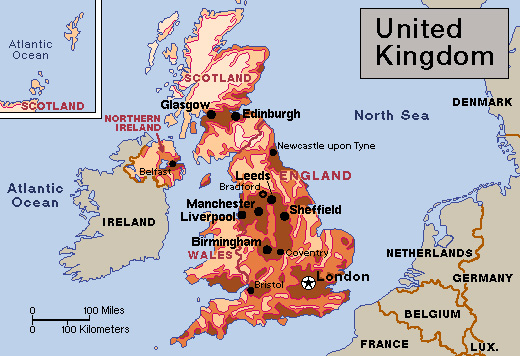
About five-sixths of the population of the United Kingdom live in England. London and England as a whole have great influence over the rest of the United Kingdom because of their large populations.
Ancestry.
Celtic-speaking people lived in what is now the United Kingdom by the mid-600’s B.C. Over the next 1,700 years, the land was invaded by a series of peoples. The chief invaders were the Romans, Angles, Saxons, Jutes, Danes, and Normans. Most of the British are descendants of these early peoples.
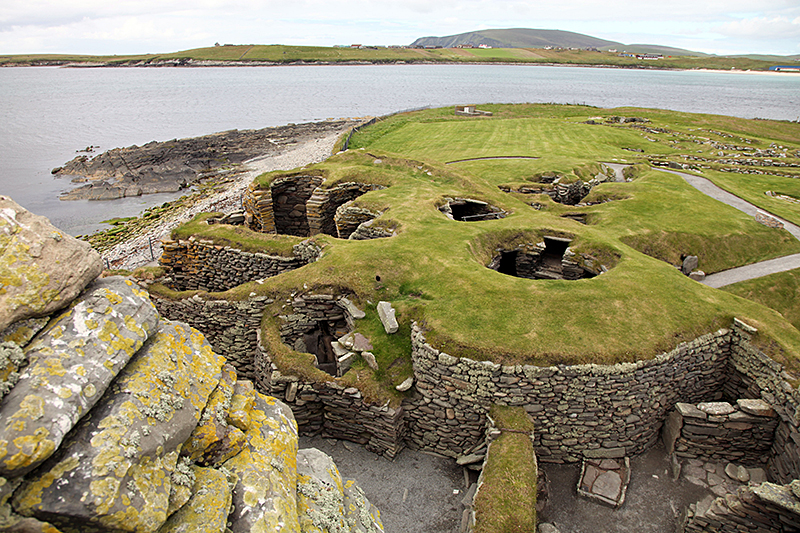
Since World War II ended in 1945, millions of immigrants have moved to the United Kingdom. Many have come from members of the Commonwealth of Nations. The commonwealth is an association of countries and other political units that were once part of the British Empire. The United Kingdom also offers asylum to refugees from around the world.
Language.
English is the official language of the United Kingdom. It is spoken throughout most of the country. English developed chiefly from the language of the Anglo-Saxon and Norman invaders.
About one-sixth of the people of Wales can speak both English and Welsh. Some use Welsh as their daily language. The Welsh language developed from one of the languages of the Celts.
Thousands of people in Scotland speak the Scottish form of Gaelic. Gaelic is another Celtic language. The Irish form of Gaelic is spoken by a small number of people in Northern Ireland.
Way of life
City life.
A number of the United Kingdom’s important cities grew rapidly in the 1700’s and early 1800’s, during the Industrial Revolution. They included including London, Birmingham, Liverpool, Manchester, and Leeds. But today, many of those cities are in decline. They are faced with such problems as falling employment, rising crime, and poor housing. They are losing population as people move into the suburbs and beyond. Greater London’s population, for example, peaked in 1939. It has been falling ever since.
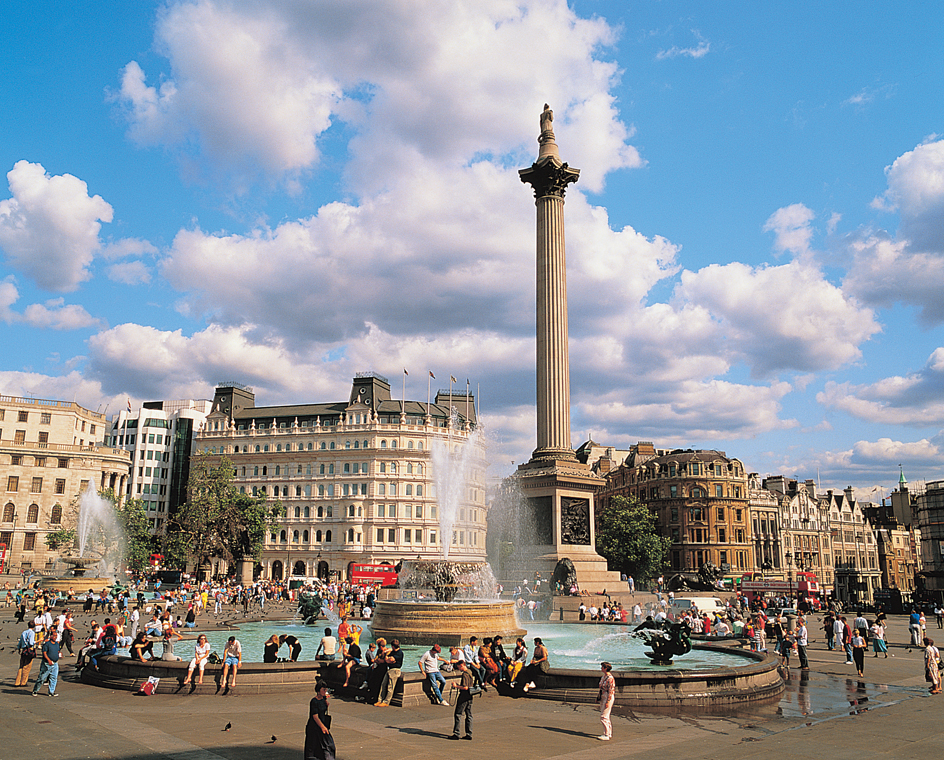
The industries that supported the growth of the large cities have declined or disappeared. New industries, such as electronics, have developed outside the cities. Many operate near motorways (expressways) or near research establishments and universities.
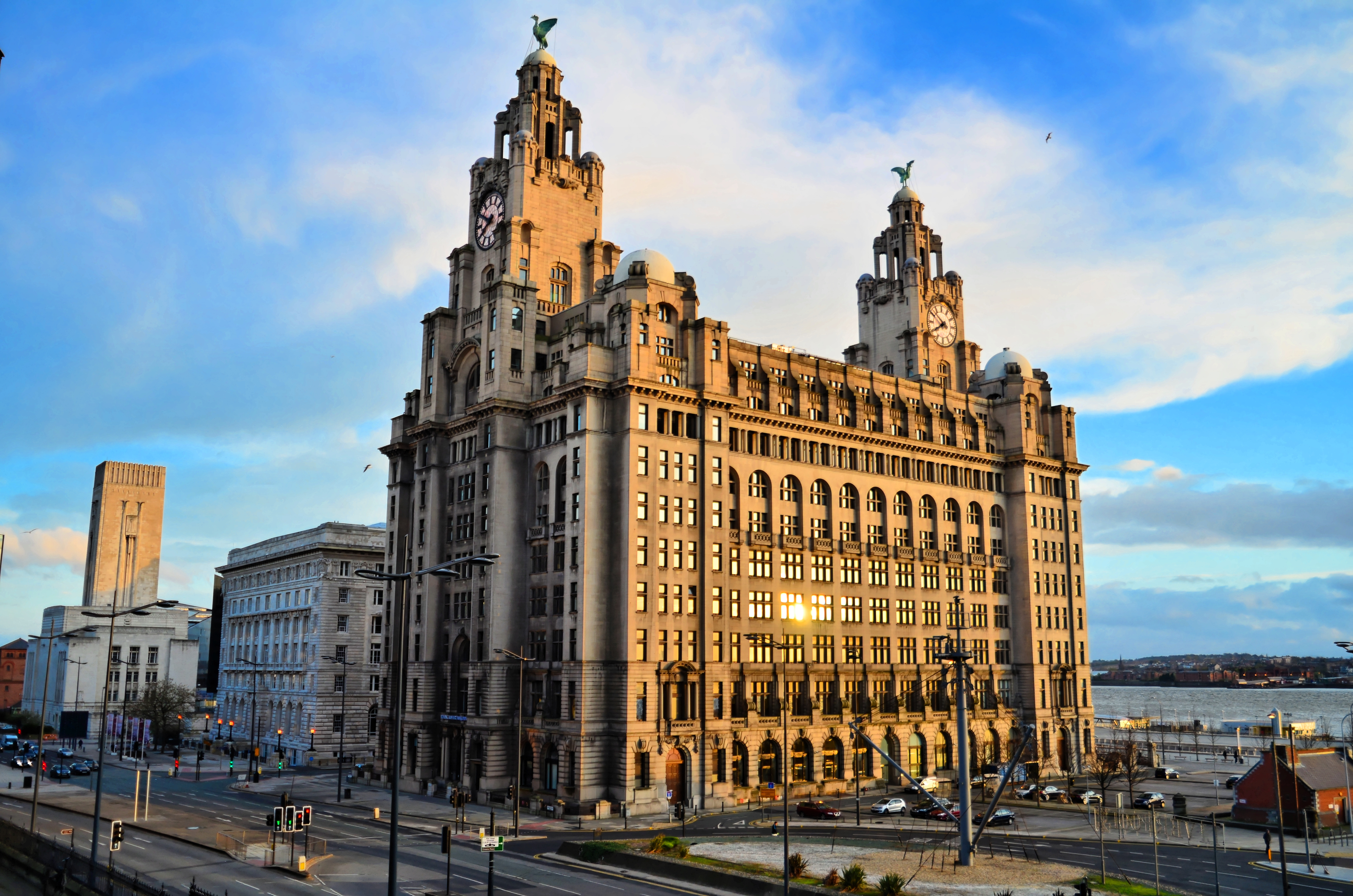
The British government in 1988 launched an urban renewal program called Action for Cities. The purpose of the program is to revive the inner cities by means of new housing and new development. The government also established areas called enterprise zones to attract new businesses to inner cities. Businesses within enterprise zones receive tax cuts and other advantages. However, people continue to move away from the inner cities to find jobs. Inner cities do not attract enough private investment. The cost of such basic services as street lighting and road repair is increasingly falling upon fewer people. And many of these people are the members of society who can least afford such costs. They include the elderly, single-parent families, the poorly paid, and the unemployed.
Rural life.
At one time, the rural areas of the United Kingdom were devoted mainly to farming. But the availability of convenient transportation enables people to work in a city and live in the countryside. In many rural communities, full-time farmers are outnumbered by retired people, commuters, and workers who serve the needs of tourists.
The attractiveness and variety of the rural United Kingdom is one of the tourist industry’s prime assets. These qualities also attract many retired people. In some rural areas, more than a fifth of the population is over retirement age. These areas include the counties of Cornwall, Devon, Dorset, East and West Sussex, and the Isle of Wight; the Scottish Borders; and parts of rural Wales.
Food and drink.
Most British cooking is simple. A typical meal includes roast beef, mutton, or pork with potatoes and one or more other vegetables. Since the 1960’s, the British have increased their consumption of poultry, fresh fruit, and frozen vegetables. Consumption of lamb, beef, veal, bread, potatoes, eggs, butter, and sugar has fallen.
Pizza houses, Chinese restaurants, and hamburger places that offer takeaway and fast food have grown in popularity. They rival the shops offering fish and chips. Fish and chips is a popular meal of fried fish and French fried potatoes. The traditional Sunday midday meal of roast beef and Yorkshire pudding is still a family favorite, however. Yorkshire pudding is a battercake baked in meat fat.
The British diet tends to be high in fat, salt, and sugar and low in fiber. These eating habits can contribute to a variety of health problems, including heart disease. The country has a high level of heart disease, especially in the north. However, health considerations have begun to influence food consumption. People drink more low-fat milk instead of whole milk. They also eat more whole grain bread, which has more fiber than white bread.
Tea with milk and sugar is the most popular hot beverage. Beer, including ale and lager, is the favorite alcoholic drink. Much beer drinking takes place in pubs (public houses). They provide a focus of social life for many people.
Recreation.
The British love the outdoors. They flock to Blackpool, Brighton and Hove, and other seaside resorts on vacation. Many vacationers visit Spain, France, and other countries. Other vacationers prefer mountain climbing. Walking in Wales or in the beautiful Lake District of northwestern England is popular. Still others enjoy automobile or bicycle trips through the country. 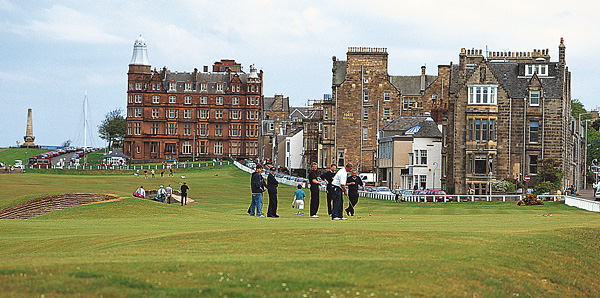
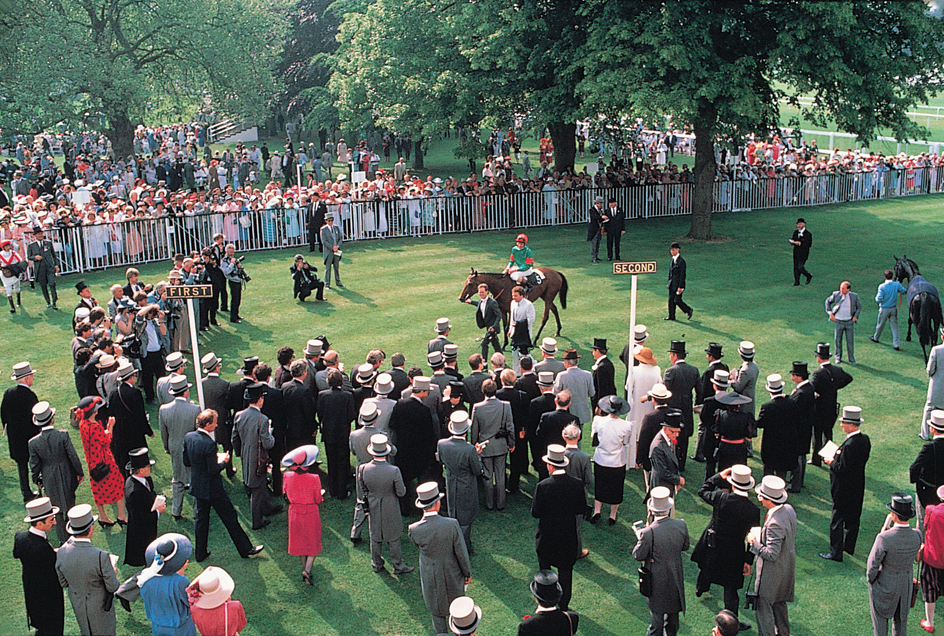

The British also spend much time in their gardens. About half of the families in the United Kingdom have a garden.
The British are enthusiastic sports fans. The most popular spectator sport by far is soccer, which the British also call football. During the football season, thousands of fans jam the stadiums. Cricket has been popular in England for hundreds of years. It is played with bats and a ball and two 11-player teams. Schools, universities, and almost all towns and villages have cricket teams. Other popular team sports include hockey and rugby football. Popular individual sports include archery, bowls (a sport similar to bowling), golf, horseback riding, horse racing, sailing, and tennis.
Religion.
The United Kingdom has two established (national) churches. They are the Church of England, which is Episcopal, and the Church of Scotland, which is Presbyterian. The monarch must belong to the Church of England and is its worldly head. The spiritual head of the English Church is the archbishop of Canterbury.
About 50 percent of the population of the United Kingdom is Christian. Most Christians are Anglican or Protestant, and about 8 percent are Roman Catholic. About 5 percent of the population is Muslim and about 1 percent is Hindu. About 35 percent of the population is nonreligious.
Education.
Each division of the United Kingdom has its own system of public education. Each system is run by its own department of education. The department works closely with local elected education authorities. The four systems differ in many ways, including the way schools are organized. Traditionally, teachers throughout the United Kingdom have had much freedom in selecting the courses they teach and in developing their own teaching methods. However, teachers are increasingly guided by a national curriculum.
Most British children are required by law to begin school at the age of 5. They continue until they are 16. Children in Northern Ireland must begin school at the age of 4. Generally, students attend elementary school until they are 11 years old. Then they go on to high school. There are several types of high schools. Some students attend grammar schools. Grammar schools provide a college preparatory education. Some attend schools that stress a more general, technical, or vocational education. However, most students attend comprehensive schools. Comprehensive schools provide all types of high school education.
Most schools in the state system are free. About 95 percent of all schoolchildren attend elementary schools and high schools supported by public funds. The rest go to independent schools.
The independent schools are private schools supported by fees paid by parents and by private gifts of money. There are several types of independent schools. The best known are the English public schools. They provide a high school education. Although they are private schools, they are called public because the earliest of these schools were established for the children of the middle classes. Traditionally, these schools have emphasized discipline, the building of character, and scholarship. The reputation of some of these schools, such as Eton, Harrow, and Winchester, is high. The leading public schools stress preparation for Oxford or Cambridge. Oxford and Cambridge are the United Kingdom’s oldest and most honored universities. 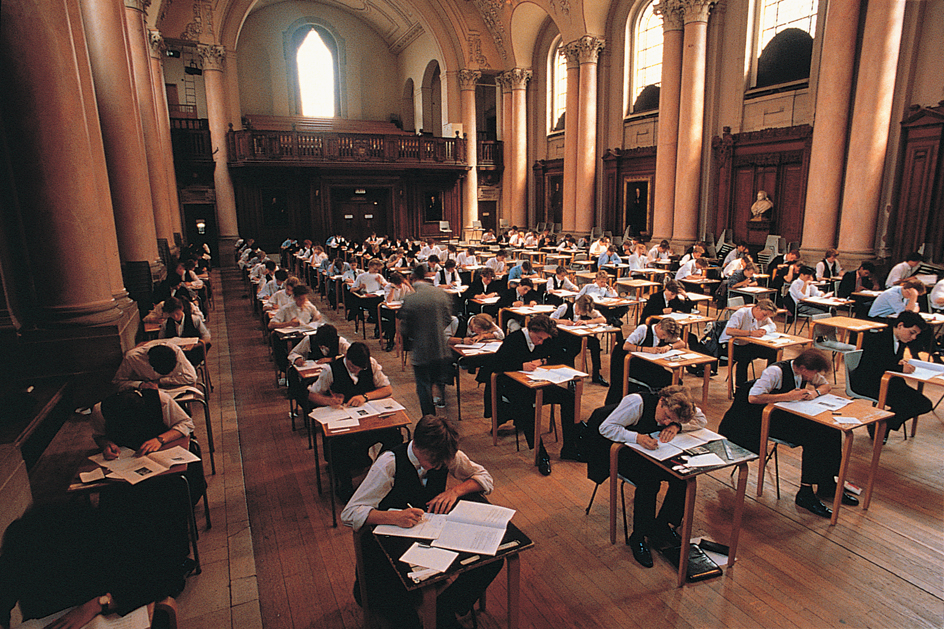
The University of Oxford was founded in the 1100’s. The University of Cambridge was established in the 1200’s. Oxford and Cambridge are famous because of their age, traditions, and high standards of scholarship. The United Kingdom has about 75 other universities. The University of London is the United Kingdom’s largest traditional university. England’s Open University has more students. But instruction is carried out through audiotapes, videocassettes, DVD’s, and the Internet, instead of in classrooms.
Museums and libraries.
The United Kingdom has about 2,500 museums and art galleries. The largest collections are owned by about 20 national museums and art galleries. Most are in London. The British Museum, in London, is famous for its collections in archaeology and other fields. The National Gallery and the Tate Britain gallery, also in London, have some of the world’s greatest paintings.

The United Kingdom’s public library system serves people throughout the country. The nation’s largest library, the British Library in London, has millions of volumes and other priceless treasures. The National Library of Scotland, in Scotland, is a center for the study of Scottish history and culture. Other important libraries include Oxford’s Bodleian Library and the Cambridge University Library.
The arts.
The government encourages and supports the arts in the United Kingdom through agencies called arts councils. There is an arts council for England, Scotland, and Wales. There is another one for Northern Ireland. Each council receives a government grant. The council, in turn, makes grants to help pay for musical, theatrical, and other artistic activities. Many local areas have their own arts councils to coordinate and finance local artistic activities.
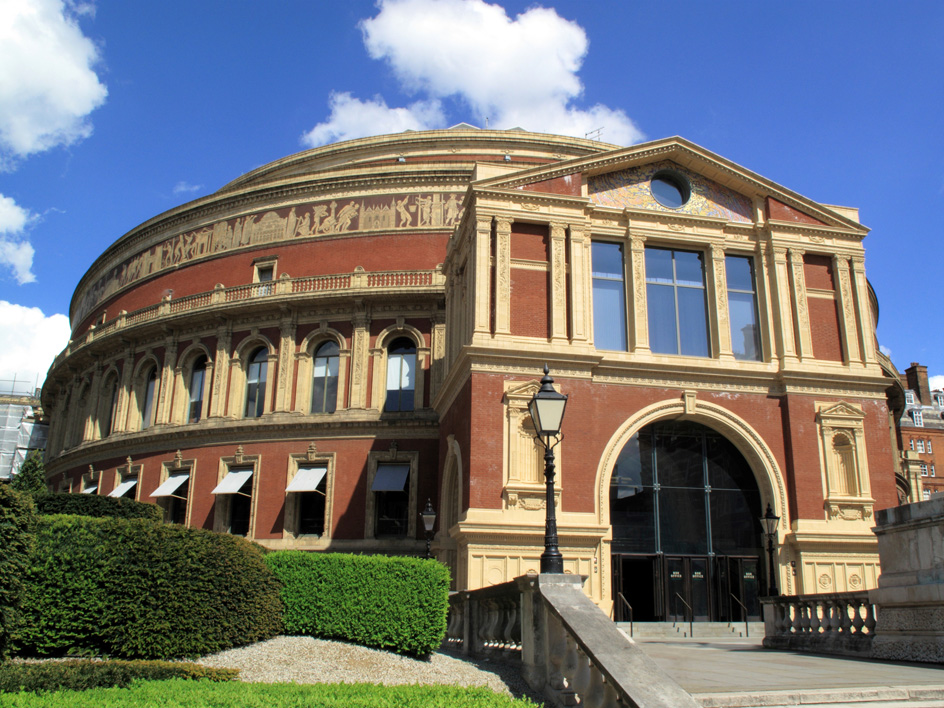
The United Kingdom is one of the world’s major centers for theater. Visitors come from all parts of the world to see British theater productions. About 50 theaters operate in the central London district known as the West End. The Royal National Theatre performs at its three stages on London’s South Bank. The Royal Shakespeare Company is based at Stratford-upon-Avon. It also performs at the Barbican Centre in London. The English Stage Company at the Royal Court Theatre in London performs the works of talented new playwrights. Notable regional theaters include the Bristol Old Vic, the Festival Theatre in Chichester, the Lyric Theatre in Belfast, and the Royal Lyceum in Edinburgh.
The United Kingdom has 11 principal professional symphony orchestras and several smaller orchestras. Five of the principal orchestras have their headquarters in London. The best-known orchestras outside London include the Hallé Orchestra of Manchester and the City of Birmingham Symphony Orchestra.
The most famous British arts festival is the Edinburgh International Festival. The festival was founded in 1947. It is held every August. Its program includes operas, concerts, ballets, and plays. The Cheltenham Festival is held in July. it specializes in music by contemporary British composers. A summer drama festival takes place in Chichester. Glyndebourne, near Brighton and Hove, has an annual summer opera festival.
The land
The United Kingdom covers most of an island group called the British Isles. The British Isles consist of two large islands—Great Britain and Ireland—and thousands of small islands. England, Scotland, and Wales occupy the island of Great Britain. Northern Ireland occupies the northeastern part of the island of Ireland. The independent Republic of Ireland occupies the rest of the island of Ireland. Some Irish people object to the term British Isles because it seems to imply that Ireland is British.
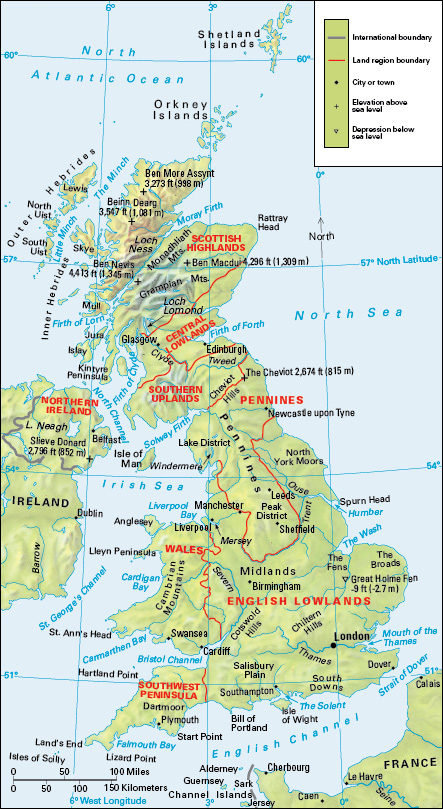
The island of Great Britain is the eighth largest island in the world. It covers 84,550 square miles (218,980 square kilometers). The North Sea on the east and the English Channel on the south separate the island from the mainland of Europe. The island of Ireland lies to the west, across the Irish Sea. The island of Great Britain is separated from mainland Europe by only about 20 miles (32 kilometers) of water at the closest point. Most of the coastline of Great Britain is broken by deep bays and inlets. No point on the island is more than 75 miles (121 kilometers) from the sea.
The United Kingdom can be divided into eight main land regions. Seven of these regions occupy the island of Great Britain. They are the Scottish Highlands, the Central Lowlands, the Southern Uplands, the Pennines, Wales, the Southwest Peninsula, and the English Lowlands. Northern Ireland makes up the eighth region.
The Scottish Highlands
cover the northern two-thirds of Scotland. They are a region of mountain ranges, plateaus, and deep valleys. The highest point in the United Kingdom rises in the Highlands. It is a 4,413-foot (1,345-meter) peak called Ben Nevis. Many bays cut into the region’s Atlantic Ocean and North Sea coasts. Some narrow bays, called sea lochs, are flanked by steep mountain slopes and reach far inland. Most of the Highlands is a moor._A moor is an area of coarse grasses, a few small trees, and low evergreen shrubs called _heather. The soil of this rugged, windswept region is thin and poor. Few people live there. Most of them raise sheep, or they fish in the seas.
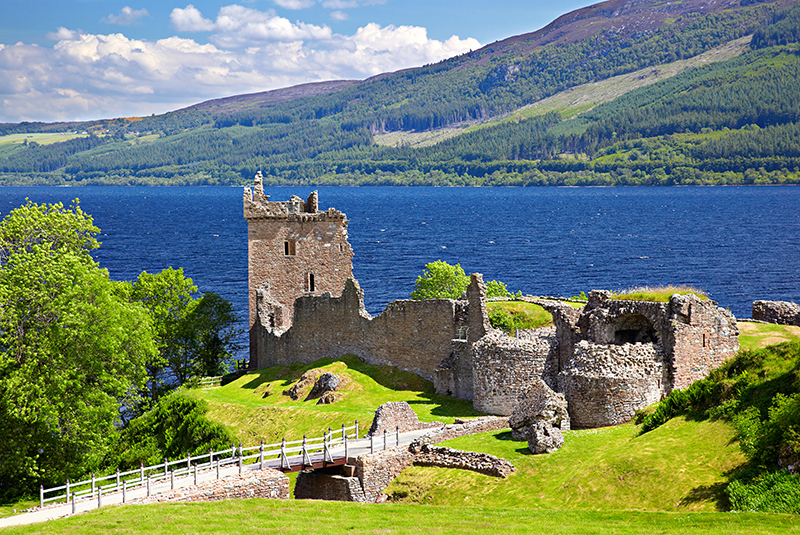
The Central Lowlands
lie south of the Scottish Highlands, in the valleys of the Rivers Clyde, Forth, and Tay. This region is a gently rolling plain. It has Scotland’s best farmland and its richest coal deposits. Most of the Scottish people live there. Most of Scotland’s industry is in the Lowlands.
The Southern Uplands
rise gently south of the Central Lowlands. This is a region of rounded, rolling hills. Sheep graze on the short grass that covers much of the hills. Their fleece goes to Scotland’s woolen mills in the region’s Tweed Valley. In the south, the Uplands rise to the Cheviot Hills. The hills form the border between Scotland and England.
The Pennines
are a region of rounded uplands that extend from the Scottish border about halfway down the length of England. They are also known as the Pennine Chain or Pennine Hills. They are often called the backbone of England. Their flanks are rich in coal. West of the Pennines lies the Lake District. The Lake District is a scenic area of clear, quiet lakes and low mountains. It is one of England’s most famous recreation areas.
Wales
lies southwest of the Pennines. It is separated from the Pennines by a narrow strip of the English Lowlands. The Cambrian Mountains cover most of Wales. These mountains are rugged in the north and more rounded in central Wales. Southern Wales is largely a plateau deeply cut by river valleys. Most of the people live on the narrow coastal plains or in the deep, green river valleys. These are the best areas for crop farming and raising dairy cattle. The rest of the land is too steep for raising crops. It is used mostly for grazing sheep and some beef cattle. Wales has large deposits of coal in the south. But most of its mines have been closed. Much of the industry of Wales is centered in the large coastal towns.
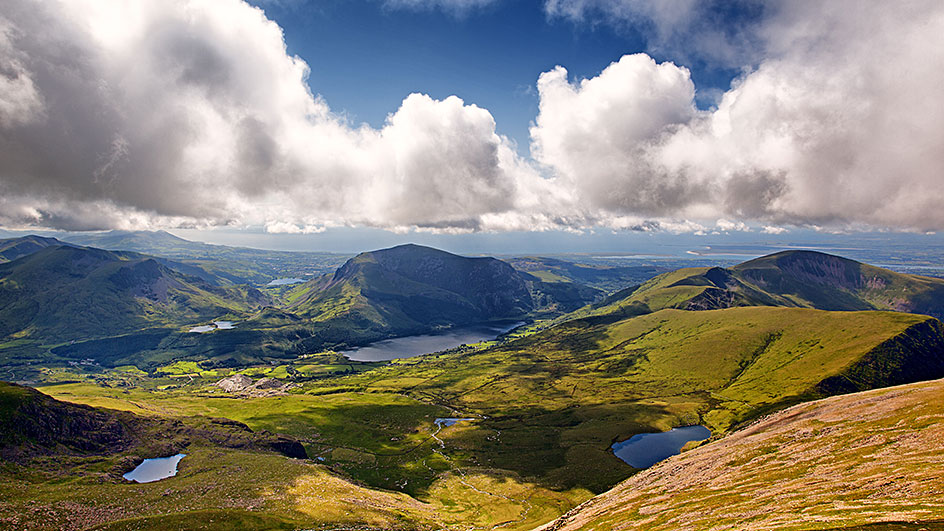
The Southwest Peninsula
lies south of Wales, across the Bristol Channel. It is a plateau whose surface is broken by great masses of granite. Near much of the coast, the plateau ends sharply in cliffs that tower above the sea. Tiny fishing villages lie in sheltered bays along the coast. The region has mild winters and summers that are not too dry. This climate helps make agriculture important in the fertile lowland areas. Farmers grow vegetables and raise dairy cattle.
The peninsula was once famous for its tin and copper mines. But most of these metals have been worked out. More important today is the region’s fine white china clay. The clay is used to make pottery. The Southwest Peninsula’s beauty and pleasant climate attract many artists, retired people, and vacationers.
The English Lowlands
cover all England south of the Pennines and east of Wales and the Southwest Peninsula. This region has most of the United Kingdom’s farmable land, industry, and people. The Lowlands consist chiefly of broad, gently rolling plains. The plains are broken here and there by low hills and ridges. Much of the land is a patchwork of fields and meadows. The fields are bordered by tall hedges, stone fences, or rows of trees. 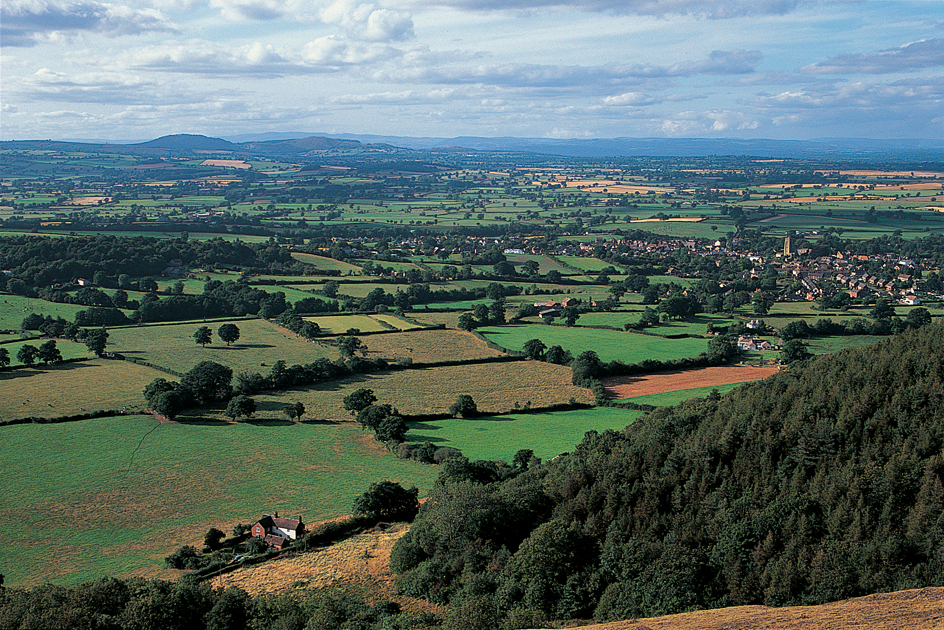
A grassy plain called the Midlands lies in the center of the English Lowlands, just south of the Pennines. Parts of the Midlands extend along the western and eastern borders of the Pennines. The Midlands are the industrial heart of the United Kingdom. Birmingham and the surrounding communities form the country’s chief manufacturing center.
South of the Midlands, a series of hills and valleys crosses the land to the valley of the River Thames. London, the United Kingdom’s capital and commercial and cultural center, stands on the Thames. Most of the land north of the Thames and up to a bay of the North Sea called the Wash is low and flat. This area has some of the country’s richest farmland. A great plain called the Fens borders the Wash. In the Fens, near Ely, is the lowest point on the island of Great Britain. It ranges from sea level to 15 feet (4.6 meters) below sea level, depending on the tide of the North Sea.
South of the Thames, low chalk hills and valleys cross the land. Where the hills reach the sea, they form great white cliffs. The most famous cliffs are near Dover. On clear days, people in Calais, France, can look across the Strait of Dover and see the white cliffs of Dover gleaming in the sun. 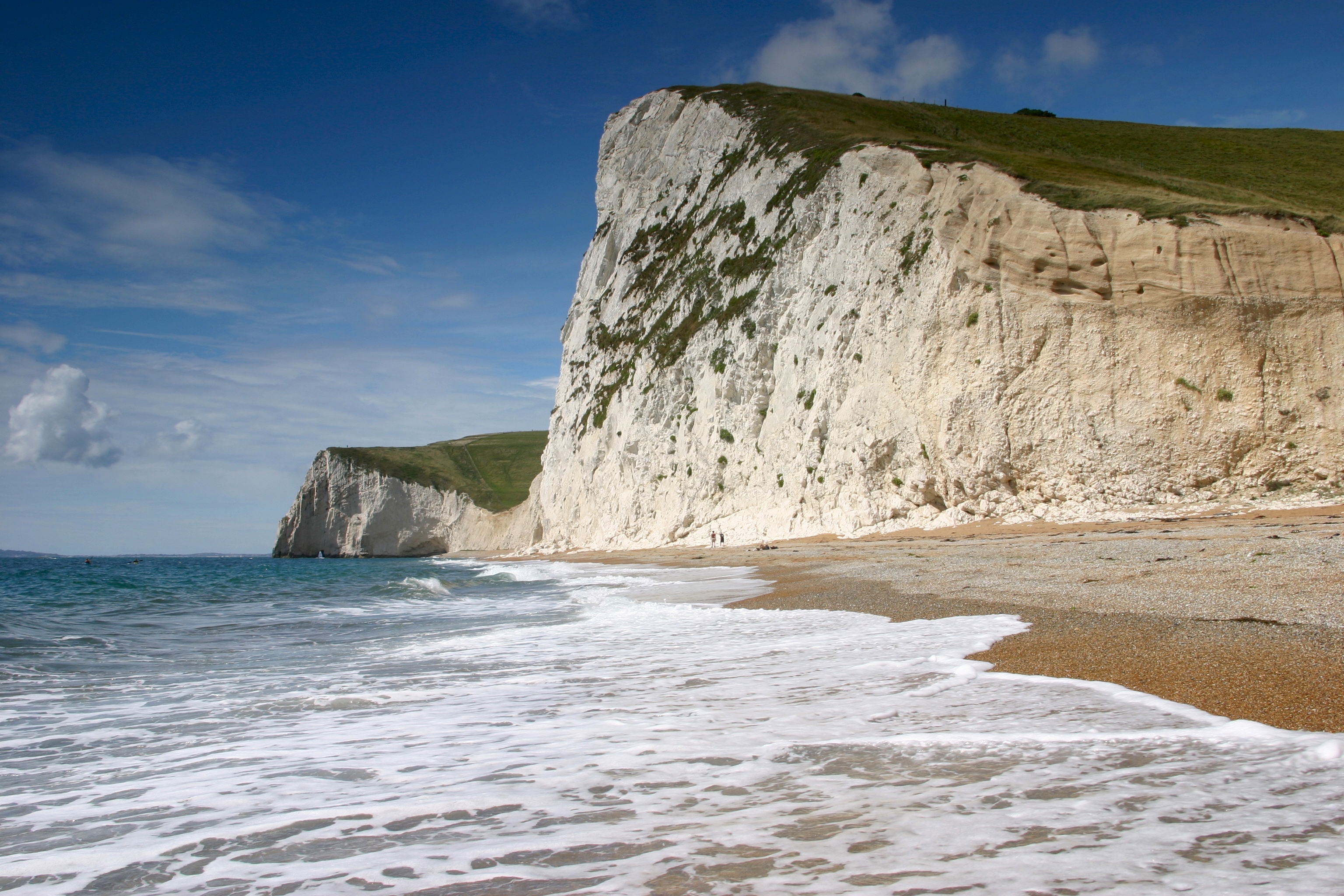
Northern Ireland
is a region of low mountains, deep valleys, and fertile lowlands. The land is lowest near the center. It rises to its greatest heights near the north and south coasts. The chief natural resources are rich fields and pastures. Most of the land is used for crop farming or grazing. 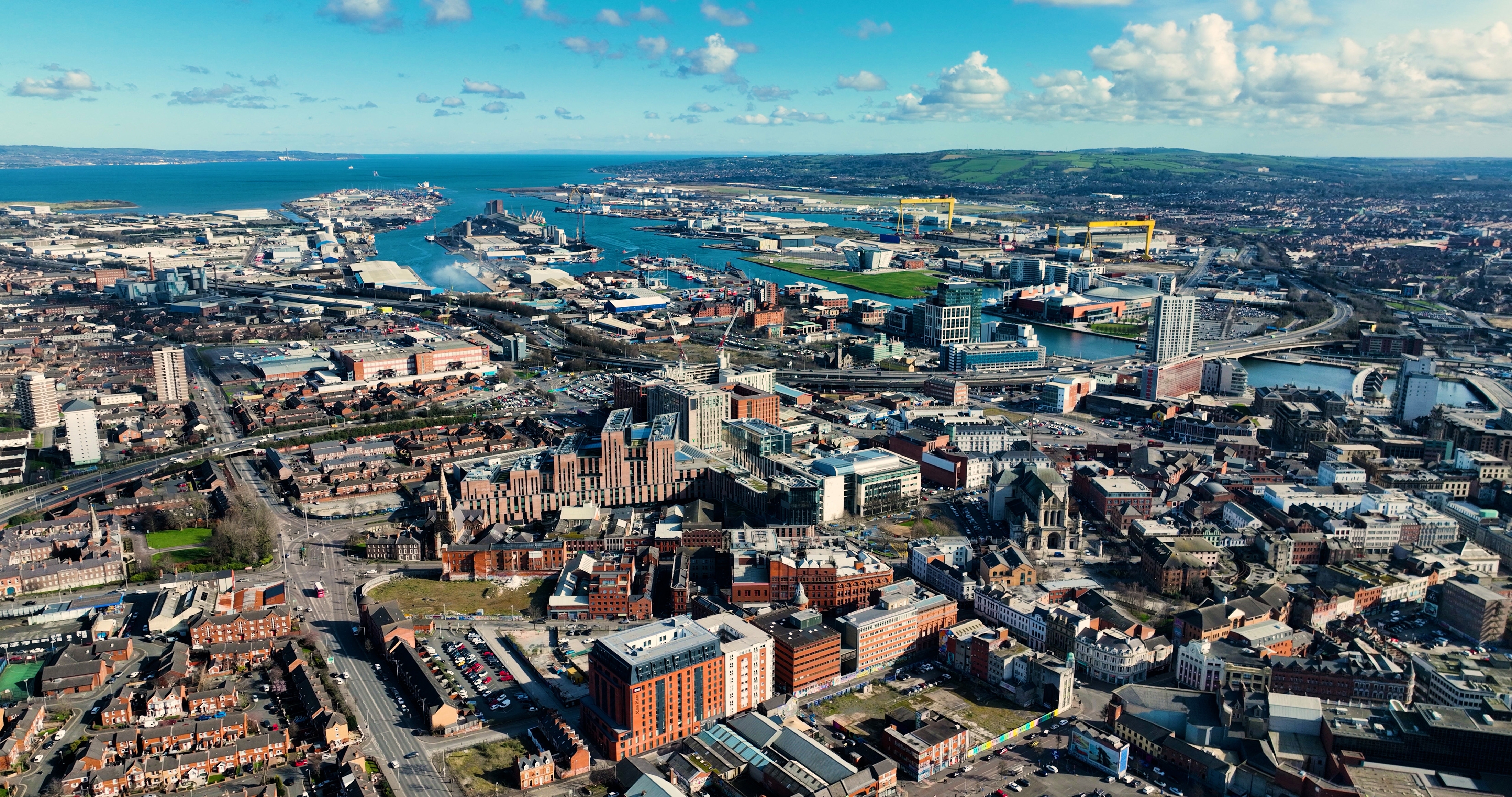
Rivers and lakes.
The United Kingdom’s longest rivers are the Thames and the Severn. The Thames is 210 miles (340 kilometers) long. The Severn is nearly the same length. Many British rivers have drowned, or sunken, mouths called estuaries. The ocean tides flow up these river mouths. Major rivers of Scotland include the Clyde and Forth of Scotland. Rivers in England include the Humber, Mersey, and Thames. The Severn flows through England and Wales. The estuaries of these rivers make excellent harbors. Bristol, Hull, Liverpool, London, Southampton, and other cities on or near estuaries are important ports.
Lough Neagh << lok NAY >> in Northern Ireland is the largest lake in the British Isles. It is about 18 miles (29 kilometers) long and up to 15 miles (24 kilometers) wide. It covers about 150 square miles (388 square kilometers). Loch Lomond in Scotland is the largest lake on the island of Great Britain. It is 23 miles (37 kilometers) long and 5 miles (8 kilometers) wide at its widest point. England’s biggest lakes are in the Lake District. The largest, Windermere, is about 10 miles (16 kilometers) long and up to 1 mile (1.6 kilometers) wide.
Climate
The United Kingdom has a mild climate, even though it lies as far north as bitterly cold Labrador. Winter temperatures rarely drop as low as 10 °F (–12 °C). Summer temperatures seldom rise above 90 °F (32 °C). The climate is influenced by the Gulf Stream. The Gulf Stream is a warm ocean current that sweeps up from the equator and flows past the islands of Great Britain and Ireland. Steady southwest winds blow across this current and bring warmth in winter. In summer, the ocean is cooler than the land. Winds over the ocean come to the United Kingdom as refreshing breezes.
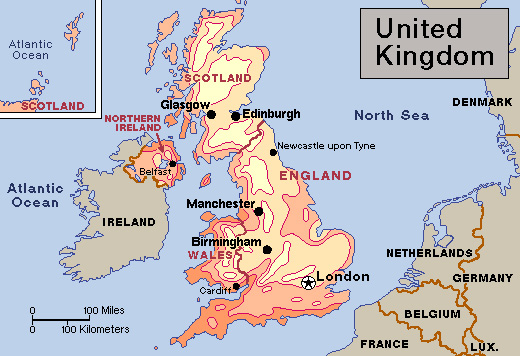
The sea winds also bring plentiful rain. The heaviest rains fall in the highland areas of western Scotland. Some of these areas get 150 to 200 inches (380 to 510 centimeters) a year. Less than 20 inches (51 centimeters) of rain falls yearly in some parts of southeastern England. The United Kingdom has rain throughout the year. Rarely is any section of the country dry for as long as three weeks. Much of the rain comes in light, but steady, drizzles.
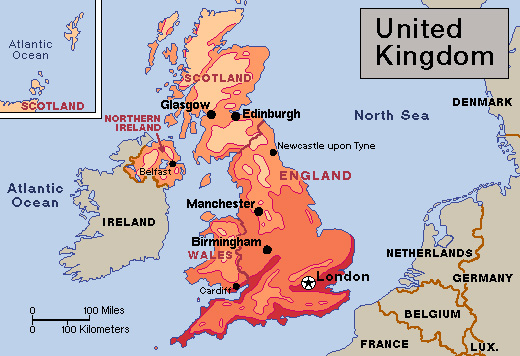
Mild fogs hang over parts of the country from time to time. But the famous “pea soup” fogs of London and other big cities seldom occur any more. These thick, heavy fogs were caused chiefly by smoke and other pollution from factories, automobiles, and homes where coal was burned for heat. Antipollution laws have helped make such fogs less severe.
Economy
The United Kingdom is an important manufacturing and trading nation. In fact, the country can survive only by manufacturing and trading. The United Kingdom’s farms produce only some of the food needed by the people. Except for coal, natural gas, and oil, the United Kingdom has few natural resources. The country must import much of its food and many of the raw materials it needs for manufacturing.
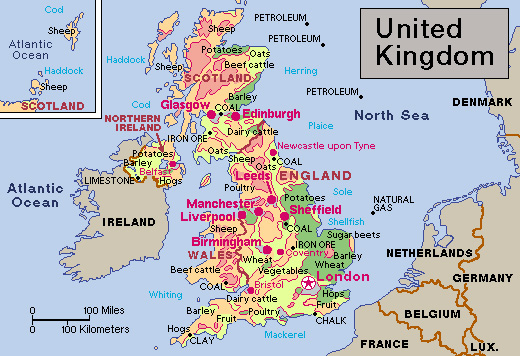
Service industries
account for about 80 percent of the United Kingdom’s gross domestic product (GDP). The GDP is the total value of goods and services produced within the country annually. About 85 percent of British workers are employed in service industries. The country’s service industries are concentrated in and near its largest cities, especially London.
Finance, insurance, real estate, and business services contributes a larger portion of the United Kingdom’s GDP than any other service industry group. Most of the country’s financial companies operate in London. London ranks as one of the world’s leading financial cities. Major financial institutions in London include the Bank of England, the United Kingdom’s national bank; the London Stock Exchange; and Lloyd’s of London insurance organization. The United Kingdom has many firms that offer such business services as accounting, advertising, data processing, and engineering.
Community, government, and personal services ranks second among the service industries of the United Kingdom in terms of the GDP. This group employs more people than any other industry in the country. It includes such activities as education, health care and social work, legal services, and military operations.
Trade, restaurants, and hotels ranks next among the service industries. Aberdeen and London are important centers of petroleum distribution. Leeds is a center for the wholesale trade of clothing. Tourist activities in the United Kingdom, especially in the London area, provide income to restaurants, hotels, and retail shops. Each year, tens of millions of tourists visit from France, Germany, Ireland, Spain, the United States, and other countries. The country’s other service industries, transportation and communication, are discussed later in this section.
Manufacturing.
The United Kingdom is a leading industrial nation. Manufacturing accounts for about 10 percent of the country’s GDP. Most British industries are in central England, the London area, the Scottish Central Lowlands, the Newcastle upon Tyne area, and southern Wales. Early factories were near the coal fields because coal powered the steam engines that moved the machinery. Today, the use of electric power, oil, and gas has enabled many new industries to develop far from the coal fields, especially in southern England.
The United Kingdom is an important steel-producing country. It exports much of its finished steel. The rest is used in the United Kingdom to make hundreds of products. Steel is used in the manufacture of automobiles, buses, trucks, and motorcycles.
The United Kingdom also produces heavy machinery for farming, industry, and mining. The country’s products include cranes, drilling machines, earth movers, harvesters, road graders, and tractors. British factories also make railway equipment, household appliances, and machine tools. The city of Sheffield is famous for its high-quality knives and hand tools.
BAE Systems, one of the world’s largest defense and aerospace companies, is headquartered in London. It supplies the armed forces of the United Kingdom, the United States, and other countries with a wide range of products. Its products include military aircraft, missiles, land warfare systems, and warships.
The United Kingdom also manufactures electronic equipment. Factories produce such items as cable television equipment, data processing equipment, fiber-optic communications systems, radar devices, and undersea telephone cables.
The chemical industry in the United Kingdom produces a variety of products. They range from industrial chemicals to plastics and soap. The United Kingdom is one of the largest exporters of pharmaceuticals (medicinal drugs). The country’s pottery industry centers in Stoke-on-Trent. Outstanding names in British pottery include Worcester, Spode, and Wedgwood.
The United Kingdom is one of the world’s chief centers of printing and publishing. British companies print paper money and postage stamps for many countries. Books published in the United Kingdom are exported throughout the world.
The Industrial Revolution began in the United Kingdom’s textile industry. Today, the United Kingdom remains an important producer of cotton and woolen textiles. British manufacturers also make synthetic fibers and fabrics. England’s east Midlands region is a center for the production of lace and knitwear. Cotton and wool are produced in northern England. Scotland produces knitwear and is famous for its fine woolen products. Northern Ireland has a worldwide reputation for its linen goods.
The United Kingdom has one of Europe’s largest clothing industries. The biggest centers are Leeds, Leicester, London, and Manchester. British clothing has long been famous for its quality. But today, the United Kingdom imports more clothing than it exports. Many countries with lower labor costs can produce clothing more cheaply than the British can.
Processing of foods and beverages ranks as one of the United Kingdom’s major industries. Most processed foods and beverages are consumed in the United Kingdom. But some are exported. Scotch whisky has a large world market. Other British industries manufacture bricks and cement, furniture, glassware, leather goods, and paper.
Agriculture.
The United Kingdom produces some of its food supply. It imports the rest. The country’s imports include various kinds of fruits and vegetables and other items that cannot be easily grown in the United Kingdom’s climate.
Farmland covers over two-thirds of the United Kingdom’s land area. The nation has about 200,000 farms. Over half of the country’s farms are less than 50 acres (20 hectares). About half of the people who operate or work on farms do so on a part-time basis.
Many British farmers practice mixed farming. That means that they raise a variety of crops and animals. Methods of mixed farming vary from farm to farm. In the rough highlands of Scotland, Wales, and western England, grass grows better than farm crops. There, farmers use most of their land for grazing. The land in southern and eastern England is drier and flatter. It is also more easily worked. Farmers in eastern England use most of their land for raising crops.
The United Kingdom’s most important crops include barley, potatoes, rapeseed, sugar beets, and wheat. The country is an important world producer of each of these crops. Farmers in southern and eastern England grow most of the country’s barley, rapeseed, sugar beets, and wheat. Potatoes are grown throughout the United Kingdom.
Farmers in southern England grow most of the United Kingdom’s fruits and garden vegetables. One of the most productive regions is the county of Kent in southeastern England. It is called the Garden of England. Kent is famous for the beautiful blossoms of its apple and cherry orchards in springtime. Farmers in Kent also grow hops, which are used in making beer. The country is among the world’s leading producers of peas and raspberries.
Sheep are one of the United Kingdom’s chief livestock. Farmers in almost every part of the country raise sheep for meat and wool. British farmers also raise beef cattle, dairy cattle, and hogs. Chickens are raised mainly in special mass-production plants. The country is one of the world’s leading producers of both milk and wool.
Mining.
The United Kingdom is one of the largest producers of both petroleum and natural gas in Europe. These fuels account for the majority of the value of total mineral production in the country.
Petroleum is the United Kingdom’s most valuable mineral. In the past, the country had to import petroleum to meet its needs. But during the 1970’s, the United Kingdom began producing petroleum from wells in the North Sea. Britain obtains natural gas from deposits below the North Sea. 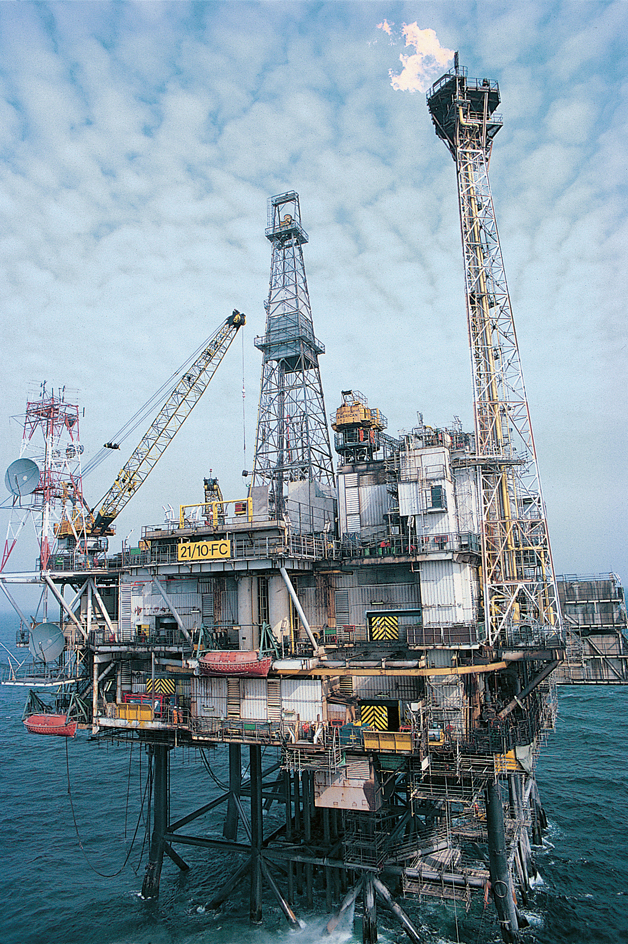
The United Kingdom’s largest coal-mining regions lie near the River Trent in central England and in North Yorkshire. Coal from these areas is an important fuel source for the country’s electric power plants.
Britain’s other important minerals include chalk, clays, flurospar, gypsum, potash, salt, sand and gravel, and stone. The Southwest Peninsula has fine china clay, used in making pottery. Southeastern England has large deposits of chalk, used for cement.
Fishing.
The United Kingdom is an important fishing nation. The British fishing industry supplies about 700,000 tons (635,000 metric tons) of fish yearly. More than half of this catch comes from the waters west of Scotland and from the northern North Sea. The principal catches include cod, haddock, herring, mackerel, and whiting. Large catches of crabs and other shellfish are also brought in. The main fishing ports are off the northeast coast of Scotland and in the southwestern part of the island of Great Britain.
Fish farms in the United Kingdom produce salmon, trout, and shellfish. Scotland is especially known for its salmon farms.
Energy sources.
Plants that burn natural gas provide much of Britain’s electric power. Nuclear energy is also important. In 1956, the United Kingdom opened the world’s first large-scale nuclear power station at Calder Hall, Cumbria, in northwestern England. An increasing percentage of the country’s power is coming from wind power.
International trade.
The United Kingdom ranks as a leading trading nation. The country once imported chiefly raw materials and exported mostly manufactured products. However, manufactured goods now account for most of the country’s imports and exports.
The United Kingdom exports aerospace equipment, chemicals and pharmaceuticals, foods and beverages, gold, machinery, motor vehicles, and petroleum. The country’s imports include chemicals, clothing, foods, machinery, motor vehicles, petroleum products, pharmaceuticals, and textiles.
Most of the United Kingdom’s trade is with other developed countries, especially the other nations of Europe. China, France, Germany, the Netherlands, and the United States are among the United Kingdom’s leading customers and suppliers. Other major trade partners include Belgium, Ireland, Italy, Japan, Norway, Spain, and Switzerland.
The value of the United Kingdom’s imports of goods usually exceeds the value of its exports. British banks and insurance companies make up part of the difference by selling their services to people and firms in other lands. Another important source of income is the spending by the tens of millions of tourists who visit the United Kingdom each year. Most of these tourists come from France, Germany, Ireland, Spain, and other European countries and also from the United States. The British merchant fleet also brings in money by carrying cargoes for other countries.
Transportation.
Roads and railways carry most passenger and freight traffic within the United Kingdom. A system of high-speed motorways links major cities and towns. Bus systems provide local and intercity transportation. Lorries (trucks) carry most of the inland freight.
An extensive rail network crisscrosses the United Kingdom. The railroads provide high-speed passenger service, as well as freight hauling.
The United Kingdom has a large merchant fleet. The ships in the fleet carry British-made goods to ports throughout the world and bring back needed imports. British ships also carry freight for other countries. There are dozens of ports of commercial significance throughout the United Kingdom. Most of the country’s international trade comes through these ports.
The country’s inland waterways are used to carry freight, as well as for recreational boating. The Thames, which flows through London, is the United Kingdom’s busiest river. It is also one of the busiest in the world.
Ferry services connect coastal and island communities in the United Kingdom. In 1994, the Channel Tunnel, or Chunnel, opened. The Chunnel is a railroad tunnel beneath the English Channel that links the United Kingdom and France.
British Airways, the United Kingdom’s largest airline, operates flights to all parts of the world. Smaller airlines provide service within the United Kingdom and to other countries. Heathrow Airport, one of the busiest airports in the world, is near London. The United Kingdom also has large airports at Gatwick and Stansted, both near London. Other large airports operate at Birmingham, Edinburgh, Glasgow, and Manchester.
Communication.
The United Kingdom has dozens of daily newspapers. Many of them have nationwide circulation. The Daily Mail, the Daily Mirror, and The Sun have the largest circulations. The most influential papers include the Daily Express, the Daily Star, The Daily Telegraph, The Guardian, and The Times.
The United Kingdom has advanced telecommunications systems, and cellular telephone service is widely available. The country also has a variety of television, radio, and Internet options. The British Broadcasting Corporation (BBC), a public corporation, provides commercial-free radio and television service. The BBC is financed chiefly by yearly licenses that people must buy to own a television set. Numerous commercial radio and television stations also broadcast throughout the country.
